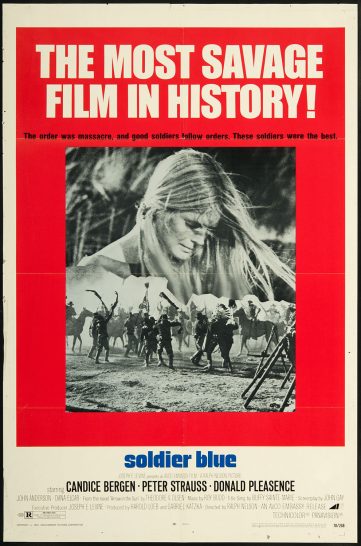 Perhaps the most infamous of the many revisionist westerns churned out by Hollywood in the early seventies. This 1970 release, eagerly heralded as the “Most Savage Film in History,” was based on Theodore V. Olsen’s 1969 novel ARROW IN THE SUN, and also the Sand Creek massacre, in which an estimated 70-500 Native Americans, most of them women and children, were slaughtered by the US Army on November 29, 1864.
Perhaps the most infamous of the many revisionist westerns churned out by Hollywood in the early seventies. This 1970 release, eagerly heralded as the “Most Savage Film in History,” was based on Theodore V. Olsen’s 1969 novel ARROW IN THE SUN, and also the Sand Creek massacre, in which an estimated 70-500 Native Americans, most of them women and children, were slaughtered by the US Army on November 29, 1864.
SOLDIER BLUE, executive produced by the notorious Joseph E. Levine and starring a young Candice Bergen, was one of the first American westerns to evince real sympathy for Native Americans. It was also one of the last notable films directed by Ralph Nelson (of classics like DUEL AT DIABLO and CHARLY), whose wishes were overridden by studio executives who insisted on enhancing the gore and brutality. That didn’t stop the film from being recut for a PG rating, in which form it was released to VHS in the US (where it wasn’t seen in its full 115 minute R rated form, on home video at least, until 2005, when Lionsgate released it on DVD). This may or may not explain why the film was successful in nearly every country but its own.
Following a textual crawl informing us that “The climax of SOLDIER BLUE shows specifically and graphically the horrors of battle as blood lust overcomes reason,” and “The greatest horror of all is that it is true,” the film opens with bloody gunshot wounds, stabbings and people set on fire. The slaughter is perpetrated by Cheyennes on an army detachment during the American Indian Wars. The only survivors are the young soldier Honus Gant and Cresta Lee, a trash talking blonde who’s just escaped from the Cheyenne’s clutches, having been taken prisoner and forced to marry the chief Spotted Wolf. Her familiarity with Native American customs helps her and the naïve Honus through the Colorado wilderness, with their biggest threat being Cu Cumber, an old white man who sells weapons to the Cheyenne and takes Honus and Cresta hostage.
They escape Cumber’s clutches, but with Honus severely wounded. After a sojourn (and some chaste romance) in a cave Cresta heads to the nearest military encampment—and then somehow ends up in the middle of the Sand Creek massacre, which is even nastier than the bloodbath that opened the film.
Of her early roles Candice Bergen (who would follow this film with THE HUNTING PARTY, another ultraviolent oater) has written that “When I wasn’t cast as the cool, rich dilettante I so resembled, I was the Snow Queen, a natural for rape scenes; the woman men love to defile,” and that would appear to have been the impetus behind her casting here. Outfitted with plastic breasts to make her look more fully endowed (the reason a planned nude scene was scuttled), Bergin looks great, but is never the slightest bit convincing as a 1800s gal. As for Peter Strauss as her love interest, his lackluster performance is a major drag on the film, although Donald Pleasance contributes some enjoyable scenery chewing as the eccentric gun runner Cu Cumber.
The major stylistic influence appears to have been Sam Peckinpah’s THE WILD BUNCH, down to the score by the British Roy Budd, which directly imitates Jerry Fielding’s famous music for Peckinpah’s classic. Imitation, regardless of how sincere it might be, doesn’t translate to quality, and this film never comes close to approaching the brilliance of Peckinpah’s classic. SOLDIER BLUE, in fact, is erratically paced and indifferently scripted, with the ingenious plotting and well integrated period detail of Theodore V. Olsen’s source novel having been largely jettisoned.
Regarding the film’s major set-piece, the Sand Creek massacre sequence, its presentation is sincere. The actual details of the massacre were much, much worse, but what we’re shown still feels gratuitous. Bergin describes the filming of the scene thusly: “There was a prosthetics truck on the set…the inside stocked with artificial limbs and every conceivable extremity. Wooden legs swung from the top of the truck and arms were stacked along the sides.” Furthermore, “Rubber breasts lay neatly in drawers, fitted with blood bags that would burst when lobbed off by the soldiers’ bayonets; and some artificial legs were wired electrically, specially rigged to simulate spasm when run over and severed by wagon wheels.” Yes, it’s a nasty and attention-getting sequence, but also an artless and long-winded one that ultimately accomplishes little more than surface-level disgust.
On the plus side there’s an extremely catchy, and very of-its-time, theme song by the Canadian First Nations singer Buffy Sainte-Marie (a future Academy Award winner for “Up Where We Belong” from the OFFICER AND A GENTLEMAN soundtrack) that’s played over the opening credits. The end credits, by contrast, take place in total silence, underlining the supposition that we’re supposed to be totally overwhelmed by what we’ve just seen—which I, for one, wasn’t.
Vital Statistics
SOLDIER BLUE
Avco Embassy
Director: Ralph Nelson
Producers: Gabriel Katzka, Harold Loeb
Screenplay: John Gay
(Based on a novel by Theodore V. Olsen)
Cinematography: Robert B. Hauser
Editing: Alex Beaton
Cast: Candice Bergen, Peter Strauss, Donald Pleasance, John Anderson, Dana Elcar, Jorge Rivero, Bob Carraway, Martin West, James Hampton, Mort Mills, Jorge Russek, Aurora Clavell, Alf Nelson
